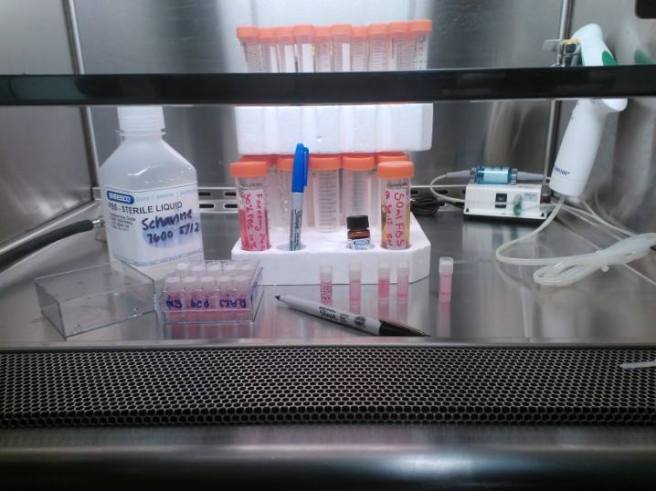I have been working in vitro with monocyte cells for the past few months. I was fortunate to receive a flask of already cultured cells from a neighboring lab – fortunate because my lab did not have to pay to procure them. However, that meant I did not have a stock supply or a back-up of the cell-line. Once you start working with cells, they have to be maintained at least every 2 to 3 days. There are only two of us currently working in my lab, so that means if I am away from the lab for an extended period of time I will have to freeze down aliquots of the cells for storage. This should be done with every cell-line you work with for the sake of continuity, amongst other reasons. Cell-lines age as you continue to work with them, and in time may begin to change in characteristics.
The process is slow but simple. Below is a brief description of how it’s done:
First, collect cells – suspended in medium – in a tube.Taking a small sample of the cells; “trypan-blue” is added to help count the number of live cells. Dead cells will take up the blue dye; do not count these!

Place a small amount of trypan-blue cell suspension onto the hemocytometer (the rectangular glass object). This device has grid-lines that aid in accurately counting the number of cells. View under a microscope like this: 
Once you know how many cells you have, you can determine how to distribute them. Aliquots (equal portions of the whole) are placed in cryo-vials. Cells are suspended in “freezing medium” that keeps them from bursting when frozen, as well as, supplies nutrients for them to stay alive during storage.

Once you have all you vials filled, label them with the cell-line name, the date, the number of cells, and your initials. The cells are then placed in a freezer storage box, standing upright, and place at increasingly colder temperatures overtime. Finally they can be stored at -80 degrees Celsius for short-term storage, or in a liquid nitrogen chamber, for long-term storage.
That’s all folks! When I get back I will thaw a sample and get right back to work. Until then, I will be absorbing some U.V. rays in sunny Barbados!
